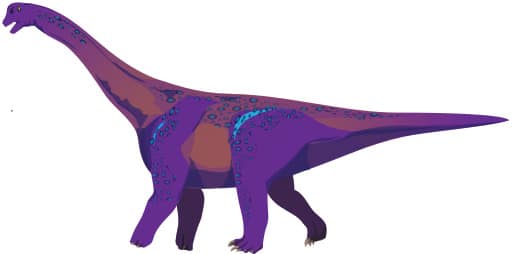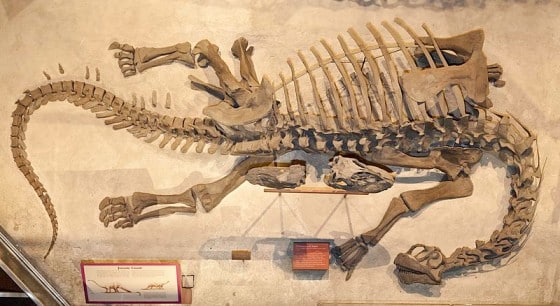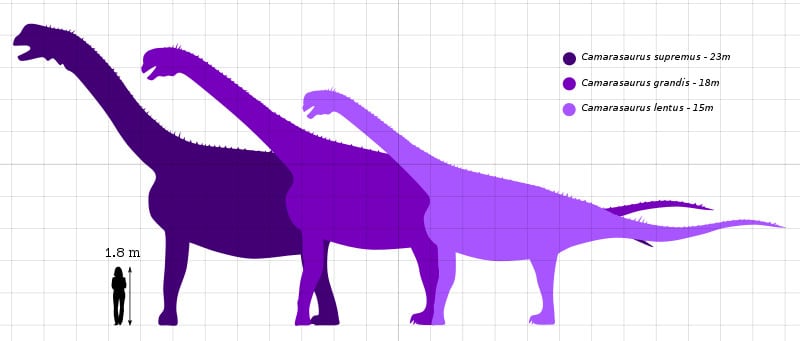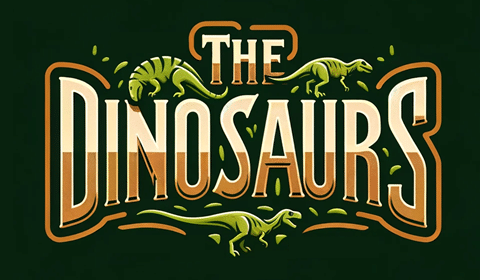Camarasaurus was a giant sauropod dinosaur that lived during the Late Jurassic around 150 million years ago. With its size, I think it’s a great example of the sheer diversity and scale of the dinosaur kingdom. This colossal herbivore wandered around the Western parts of what we today know as North America.
There are four different species of Camarasaurus, and it is possibly the best documented of all sauropods with hundreds of specimens discovered. Through the different geological strata (layers of rock) one can almost see the dino evolve through time.
Camarasaurus Key Facts
| Keyword | Fact |
|---|---|
| Camarasaurus pronunciation | ka-MAR-uh-SOR-us |
| Meaning of name | Chambered lizard |
| Group | Sauropodomorpha |
| Type Species | Camarasaurus supremus |
| Diet | Herbivore |
| When it Lived | 155.7 to 145.0 MYA |
| Period | Late Jurassic |
| Epoch | Late/Upper Kimmeridgian to Early/Lower Tithonian |
| Length | 59 – 75.0 feet |
| Height | 14-17 feet at the hips |
| Weight | 25 – 52 US tons |
| Mobility | Moved on all four legs |
| First Discovery | 1877 by Oramel William Lucas |
| Location of first find | Colorado, USA |
| First Described by | 1877 by Edward Drinker Cope |
| Holotype | AMNH 560 |
Camarasaurus Taxonomy and Timeline

Camarasaurus, means ‘chambered lizard’. It gets its name from the hollow chambers found inside its vertebrae. This unique feature not only gives the dinosaur its name but also provides insight into its evolutionary adaptations.
It belongs to the group Sauropodomorpha, known for their long necks and tails and small heads, and the more specific family Camarasauridae.
The holotype is Camarasaurs supremus, and there are three more species of Camarasaurus, namely C. grandis, C. lentus and finally C. lewisi. Not all paleontologists agree that C. lewisi should be recognized as a Camarasaurs as at all, but instead consider it a different genus.
Evolution of the Species Over Time
The four species of Camarasaurus lived during the Late Jurassic period around 155 to 145 million years ago. This period was characterized by a warm and humid climate with lush vegetation, providing the perfect environment for this herbivorous giant.
Camarasaurus supremus, true to its name, was the biggest species of Camarasaurus. It is also one of the largest sauropods from the late Jurassic Morrison Formation. Apart from its massive size, it was almost identical to C. lentus. However, C. supremus has proven to be a rare find, only appearing in the youngest and uppermost layers of the formation. This is unlike the other species of Camarasaurus, which were more common in earlier periods.
The sequence of rock layers in the Morrison Formation (which is one way used to find the age) gives us clues about how these species evolved over time. C. grandis was the oldest and lived in the lowest layers. C. lewisi appeared briefly alongside C. grandis but vanished early on. This might just mean there are not as many fossils, not necessarily that the species went extinct.
C. lentus came later, overlapping with C. grandis for a few millions of years, likely because they thrived in different environments. This is based on differences found in their spines. Eventually, C. grandis disappeared, leaving C. lentus as the dominant species.In the uppermost layers, meaning the time closest to our own, C. lentus also vanished, and C. supremus took its place. This seemingly seamless transition between the two might suggest that C. supremus have evolved from C. lentus, growing larger over time and becoming the last of its kind in the Morrison Formation.
Fossil Evidence
The first discovery was made in 1877 in Colorado, USA by Oramel William Lucas. The dinosaur was later described by Edward Drinker Cope, marking a significant milestone in the study of prehistoric life.
Since then, numerous other fossils have been found across the United States, particularly in the Morrison Formation—a sequence of sedimentary rock from the Late Jurassic period. All in all, more than five hundred different discoveries of Camarasaurus fossils have been found in the USA. The vast majority is of single, or only a few bones, but there are several partial skeletons, as well as five nearly complete skeletons. It makes Camarasaurus among the most commonly found sauropod dinosaur.
These fossils have provided invaluable insights into the dinosaur’s physical characteristics and lifestyle. These fossils were described by Cope later that year.

As I noted already, many fossils are notable for their excellent preservation, allowing scientists to study the dinosaur in great detail. With several, nearly complete skeletons, they offer a comprehensive view of the dinosaur’s anatomy.
One of the most notable specimens is a nearly complete skeleton of a juvenile Camarasaurus discovered in Dinosaur National Monument in Utah. This specimen has provided unique insights into the growth and development of the Camarasaurus and has shared a rare glimpse into the life of a juvenile dinosaur.
Camarasaurus Size and Description
Camarasaurus was (like you would envision any sauropod) a large, quadrupedal dinosaur, characterized by its long neck and tail and a relatively small head. Its vertebrae were uniquely hollow, leading to its ‘chambered lizard’ name. The dinosaur’s limbs were robust to support its massive body weight, while its tail likely served as a counterbalance for its long neck. The skin, like that of many dinosaurs, is believed to have been rough and scaly.
It moved on all four legs—a common trait among sauropods. While its speed is not definitively known, it is generally believed that it was not particularly fast given its size and body structure.
Size and Weight of Camarasaurus Species

This herbivorous dinosaur was a true giant among dinosaurs. The type species, Camarasaurus supremus, is estimated to have reached lengths of up to 75 feet and stood about 15 feet tall at the hips. Its weight is estimated to have been around 20 tons. These estimates, however, can vary based on different fossil specimens and interpretations by paleontologists.
The size of Camarasaurus made it one of the largest land animals of its time. Its massive size likely played a crucial role in its survival and provided it with a certain degree of protection against predators.
The Dinosaur in Detail
Camarasaurus is set apart from other dinosaurs by its unique features and adaptations. Its most distinguishing feature, the hollow chambers in its vertebrae, not only gives the dinosaur its name but also reflects its adaptability and survival instincts.
The hollow vertebrae of Camarasaurus likely served multiple purposes. They would have reduced the weight of the dinosaur’s massive body to make movement easier. Additionally, these chambers could have housed air sacs, similar to those found in modern birds, potentially aiding in respiration and temperature regulation.
One notable specimen is a nearly complete skeleton of a juvenile, discovered in Dinosaur National Monument in Utah. This specimen has provided unique insights into the growth and development of Camarasaurus and has shed light on aspects such as its growth rate and lifespan.
Camarasaurus in its Natural Habitat
It lived during the Late Jurassic period, a time characterized by a warm and humid climate with lush vegetation. This environment would have provided abundant food sources for this herbivorous dinosaur, contributing to its massive size.
As an herbivore, it likely fed on a variety of plant life, including ferns, cycads, and conifers. Its strong, robust teeth would have allowed it to handle coarser plant material, setting it apart from other sauropods.
It moved on all four legs, a trait common among sauropods. This mode of locomotion combined with its massive size would have made this a slow-moving creature. Despite its slow speed, its size would have offered some protection against predators.
The social behavior is not definitively known but it is generally believed that, like many sauropods, it lived in herds. Living in groups could have offered additional protection against predators and facilitated access to food sources.
Interesting Points about Camarasaurus
- It had a relatively short, boxy skull—a feature that distinguished it from other sauropods.
- Unlike many sauropods, it had strong, robust teeth that indicated that it could feed on coarser plant material.
- The discovery of a nearly complete juvenile skeleton has provided unique insights into the dinosaur’s growth and development.
- This is one of the most frequently found dinosaurs in the Morrison Formation, a sequence of sedimentary rock from the Late Jurassic period.
- The hollow chambers in the vertebrae could have housed air sacs, potentially aiding in respiration and temperature regulation.
Contemporary Dinosaurs
Allosaurus, Apatosaurus, Brachiosaurus, and Brontosaurus all shared some part of their existance with the Camarasaurus. These fellow dinosaurs, some friend and some foe, played their parts between back-and-forth interactions that shaped their ecosystem.
Imagine, if you will, Camarasaurus roaming alongside Allosaurus, a dinosaur that was considerably smaller but still dangerous. This smaller contemporary was known for its agility and predatory nature and might have posed a threat to the younger or weaker members of Camarasaurus herd. The interplay between these two species, one a gentle giant and the other a swift predator, would have been a fascinating spectacle of the survival instincts that ruled the prehistoric world.
In contrast, Apatosaurus and Brachiosaurus, both larger than Camarasaurus, would have been less of a direct threat. These towering herbivores have coexisted relatively peacefully with Camarasaurus despite competing for the same resources. Their sheer size and strength could have deterred predators in order to create a safer environment for our dinosaur to thrive in.
Brontosaurus, another contemporary of similar size and diet, adds another layer to this prehistoric narrative. The interactions between these large herbivores included possible competition for food and territory and paint a picture of a vibrant and dynamic ecosystem. Through this exploration, we gain a deeper understanding of Camarasaurus’s life and environment, a testament to the intricate and interconnected web of prehistoric life.
List of All Dinosaurs
We have created a list of all dinosaurs we have covered here, sorted across the seven main groups of dinosaurs. We also include information about their type of diet, (omnivore, herbivore or carnivore) and the time they lived.
Frequently Asked Questions
The name translates to ‘chambered lizard’, a reference to the hollow chambers found in its vertebrae.
It lived during the Late Jurassic period.
It was an herbivore that ate a variety of plant life, including ferns, cycads, and conifers.
Like most sauropods, it would have moved about quadrupedally—on four legs.
Oramel William Lucas discovered the first fossil in 1877.
Sources
- https://upload.wikimedia.org/wikipedia/commons/0/0b/On_a_Gigantic_Saurian_From_the_Dakota_Epoch_of_Colorado.pdf
- https://www.researchgate.net/publication/272152601_Distribution_and_biochronology_of_Camarasaurus_Dinosauria_Sauropoda_from_the_Jurassic_Morrison_Formation_of_the_Rocky_Mountain_Region
- https://www.academia.edu/230509/New_Juvenile_Sauropod_Material_from_Western_Colorado_and_the_record_of_Juvenile_Sauropods_from_the_Upper_Jurassic_Morrison_Formation
- https://www.researchgate.net/publication/260001296_The_fauna_and_flora_of_the_Morrison_Formation
- https://www.sciencedirect.com/science/article/abs/pii/S1871174X15000906
Article last fact checked:Joey Arboleda, 14-01-2025
Featured Image Credit: Carnegie Museum of Natural History CC 2.0
